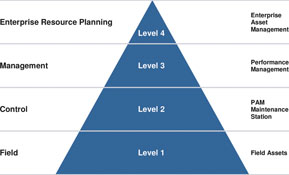
Keywords: [Asset management, condition-based maintenance, condition-based monitoring, control, instrumentation, KPI, load-based maintenance, OEE, plant asset management, ROI, savings, strategy, TCO, TEEP, time-based maintenance].
Abstract
In this paper Rolf Köstlin discusses how owners can optimise the overall availability and efficiency of their process plant equipment, and at the same time reduce their maintenance costs. Using modern plant asset management (PAM) techniques with realtime condition monitoring of all critical assets – including control, instrumentation, electrical and physical plant equipment – unwanted asset failures can be predicted and corrected before they lead to production losses.

The paper addresses different types of maintenance strategies and quotes research that shows that up to 90% of maintenance costs can be saved by adopting the appropriate strategy.
Introduction
The frequently quoted statement from a report by the E.I. du Pont de Nemours Company that “the largest single controllable expenditure in a plant today is maintenance, and in many plants the maintenance budget exceeds annual net profit” clearly highlights the importance of finding new ways in which we manage our plant assets. It is estimated in industry that maintenance related costs account for up to 40% of a plant’s total operational costs. By adopting a new culture on plant asset management, several operations around the world have successfully turned maintenance from being the 'largest single controllable expenditure' to being a source of profit. Through proper plant asset management, assets can not only be maintained close to their original state but their lifespan can actually be extended and the individual and collective asset efficiencies notably enhanced throughout the entire lifecycle of the plant. The result is to maximise the benefits (profits) derived from these assets (improved ROI).
Much has been researched, written and presented on plant asset management philosophies and strategies. This paper focuses on plant asset management predominantly at the field and control levels of the plant operational hierarchy, but also touches on the systems that are employed at the higher levels (see Figure 1 – Simplified plant operational hierarchy). Examples of condition monitoring are described to demonstrate how non-intelligent assets can effectively be managed.

What is meant by 'plant asset management'?
Process plants are associated with high capital expenditure and operational costs. Plant asset management is a collective of corporate culture, strategies, methodologies, systems and procedures aimed at maximising the benefits derived from all material and human assets in a plant. Assets should not be viewed as costs but rather as an investment towards achieving high productivity (quality and quantity) and profits.
How does plant asset management work?
In order to maximise the output of a plant, all assets need to be maintained at certain intervals – ie, monitored, serviced, refurbished or replaced. Plant asset management assists in determining these intervals through continual asset condition monitoring, predicting time-to-service, providing detailed diagnostics with guidance of required service actions and system supported planning and execution of service tasks.
Effective plant asset management requires the buy in of all plant staff members. It also involves all levels of the plant operational hierarchy, namely the process or field level 1, the control and operator level 2, the management level 3 and the enterprise resource planning level 4.
Continued on the web
For the complete article visit www.instrumentation.co.za/+C9208
For more information contact Rolf Köstlin, Siemens, +27 (0)11 652 3680, [email protected], www.siemens.co.za
| Tel: | +27 11 652 2000 |
| Email: | [email protected] |
| www: | www.siemens.co.za |
| Articles: | More information and articles about Siemens South Africa |

© Technews Publishing (Pty) Ltd | All Rights Reserved